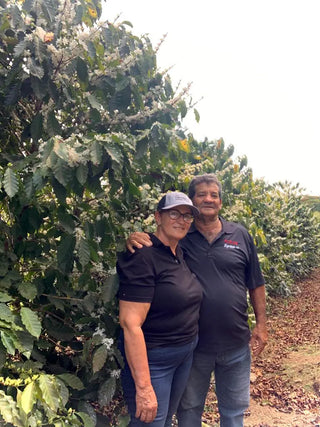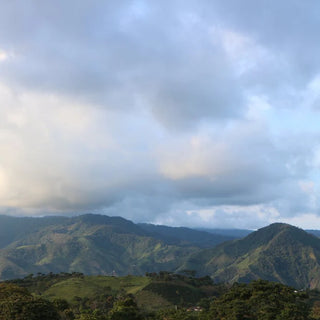
Les composants du BACKYARD changent en même temps que les récoltes, soulignant les cycles de récolte et célébrant la saisonnalité du café. Nous avons combiné les grandes qualités fruitées de chaque composant et laissé la douceur s'exprimer.
Les composants du BACKYARD changent en même temps que les récoltes, soulignant les cycles de récolte et célébrant la saisonnalité du café. Nous avons combiné les grandes qualités fruitées de chaque composant et laissé la douceur s'exprimer.

Brazil: Fazenda Serrinha Farm
Antônio Sergio da Silva began his coffee career in 1985 alongside his wife, Maria Aparecida Silva. They worked together on leased land, producing coffee and raising their three children with their farming income. In 2010, the couple purchased Fazenda Serrinha in São Gotardo, Minas Gerais, which occupies a good location for coffee growing due to its altitude and microclimate. Today, Antônio and Maria cultivate 15 hectares of Catuai and Catigua plants across the 25 hectare property.

Brazil: Red Catuai, Natural processing
This lot of Red Catuai coffee underwent Natural processing. Catuai was developed by the Instituto Agronomico (IAC) of Sao Paulo State in Campinas, Brazil by crossing Mundo Novo and Caturra varieties. Catuai coffees are cultivated widely across Brazil, and are known for their high productivity potential.

Brazil: Cerrado Mineiro
The Cerrado Mineiro region, located in northwest of Minas Gerais State, is a world-recognized, high-quality coffee producing origin and became the first Protected Geographical Indication in Brazil in 2005, with full Designation of Origin in 2013. A strong characteristic of this region is its well-defined seasons—a hot, wet summer followed by a pleasantly dry winter. The dry climate during harvest eliminates potential problems with humidity during the drying process.
Minas Gerais is Brazil’s principal agricultural state, and the Cerrado is home to many of the country’s celebrated coffee estates, with expertise in planting, harvesting, drying, and sorting. We love Cerrado coffees for their big body, rich chocolate notes, and velvety texture when pulled as espresso.
Today, the area’s 4,500 farmers produce a combined average of 6 million bags per harvest, with an average of 35 bags per hectare. To reach these production levels, producers had to first adapt to the region’s conditions. Coffee farmers first arrived in Cerrado in the 1970’s, after being pushed out of the state of Parana by frost and out of the state of Sao Paulo by nematodes. They found the soil in Cerrado to be very acidic, which they rectified with the application of calcium to create the healthy soils they enjoy today.
Cerrado coffee farms are cultivated in areas with elevations varying between 800 and 1,300 meters above sea level and are known for consistently producing high quality coffees with a repeatable profile. Independent of farm size, the spirit of professionalism is present throughout Cerrado’s coffee producers. Entrepreneurialism is part of farmers’ DNA, and many producers are second or third generation growers who also hold degrees in agronomic engineering, business management, and administration. While each family narrative is different, Cerrado is characterized by an enterprising attitude.

Colombia: Harvest & Post-Harvest
Farmers here are mainly smallholders. In fact, 80% of coffee farms are smaller than 3 hectares. On smaller farms, nearly all labor is done by the family. Very few farms hire farmhands. As a result, quality can be carefully controlled and families can focus more energy on intensive farming practices that result in high quality coffee. Families take great pride in their coffee production.

Colombia: Pitalito Region
Pitalito lies in the southernmost part of Huila. Producers are focused almost exclusively on producing specialty coffee. While the majority of trees are either Castillo or Caturra, farmers in Pitalito also cultivate more ‘exotic’ varieties than any other region in Colombia.
The high altitude of 1,400 to 1,900 meters above sea level is made even more farmable by the amiable geography. Thanks to gentle, rolling hills, Pitalito is much easier to farm than the steep cliffs that are common in many other regions in Colombia. Most farms sit on a large plateau that looks over the Valley of Laboyos.

Colombia: Varieties and Process
Castillo, Caturra. Fully washed.
Supremo Grade: screen sizes remain fairly uniform across countries but grade names are often unique to the country of origin. In the Colombian grading system, Supremo is the largest size bean.
The process of separating beans by size is a crucial stage of the dry milling process. A screen grading machine has a series of screens stacked on top of each other. Green coffee is fed into the machine, and as the screens are shaken, beans that are smaller than holes on a specific screen will fall through to a lower screen until they reach a screen with holes too small for them to fit.
Supremo is typically screen sizes 17 to 18.













